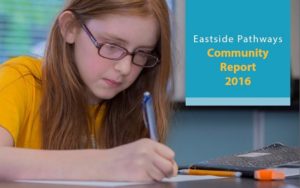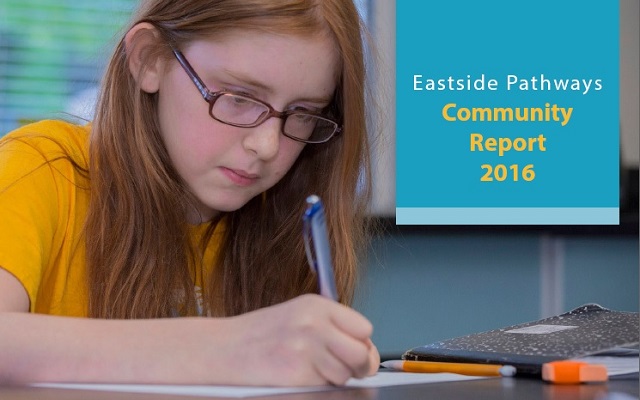BELLEVUE, WA (April 3, 2017) – Bellevue is growing both in numbers and in its diversity and that is mirrored in its student community:
- In 2016, Bellevue School District enrollment topped 20,000 students and reflected rich racial and ethnic diversity. The student population was 38% White, 38% Asian, 12% Hispanic, 9% Two or More Races, 3% Black, and under 1% Pacific Islander or American Indian.
- 95 first languages are spoken in the district, the top two being Spanish and Mandarin Chinese, and 35% of students speak a first language other than English
- Over 3,700 students(19%) receive free or reduced-price meals at school
- 14% are English Language Learners
- Homelessness is on the rise and affects more than 1 in 100 children
 Our latest Community Report highlights the troubling fact that outcomes are highly inequitable for some groups of students—a fact that people often miss when looking only at the strong overall performance of Bellevue schools. For instance:
Our latest Community Report highlights the troubling fact that outcomes are highly inequitable for some groups of students—a fact that people often miss when looking only at the strong overall performance of Bellevue schools. For instance:
- Only half of Hispanic and Black students demonstrated proficiency in third grade reading in 2016 (compared to at least 80 percent of other students). Gaps based on family income, English language ability, special education status, and homelessness were similarly large—anywhere from 28 to 46 points.
- Bellevue’s plans to expand access to early learning for young children were dealt a blow in June 2016 by the surprise elimination of all 151 Head Start preschool slots for low-income children. Even worse, the district will not have an opportunity to apply to replace the slots for five years.
View Community Reports | View Data Dashboard
Since 2011, Eastside Pathways has been focusing on aligning efforts and building relationships across organizations to address the systemic barriers that hold some students back. Recognizing inequitable preschool access as a systemic barrier, Eastside Pathways helped mobilize the community around the elimination of the Head Start preschool slots. Partners including the Bellevue Schools Foundation, the school board, the City of Bellevue, and Child Care Resources secured emergency funding to backfill for the first year of cuts. The future of access for our low-income children for the next four years is still in doubt and will require a bigger community effort.
These and many other equity gaps are highlighted in the Eastside Pathways Community Report. The message is clear: we need to do close these gaps; we need to work collectively to ensure that every child is given the same opportunities to succeed.
The value of our partnership has been clear in strengthening community engagement practices. Just a few years ago, most organizations had to do community engagement on their own. Eastside Pathways introduced the Community Café model in 2014 as a common engagement tool and followed up in 2016 by launching the Promotores program, a way to harness the knowledge and leadership skills of our local Latino community. One of the communities most impacted by educational inequity is now leading the work. That is systems change.
“We are united by the vision of a community where every child is happy, healthy, and successful,” says Stephanie Cherrington, Executive Director, Eastside Pathways. “We believe that only by working collectively and changing systems will we be able to create the supportive environment for our children to succeed.”
Article written by Sujata Agrawal, communications manager at Eastside Pathways

